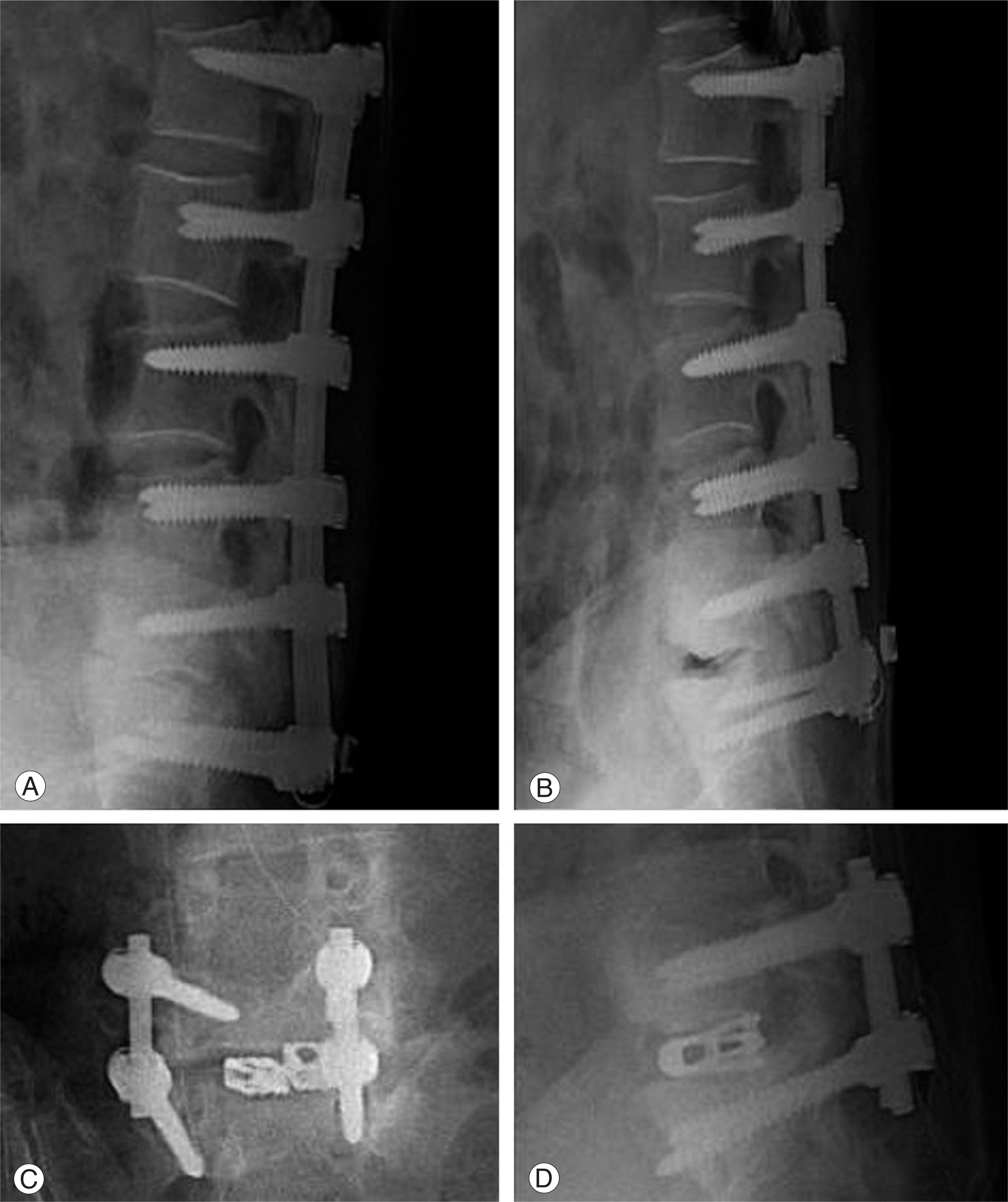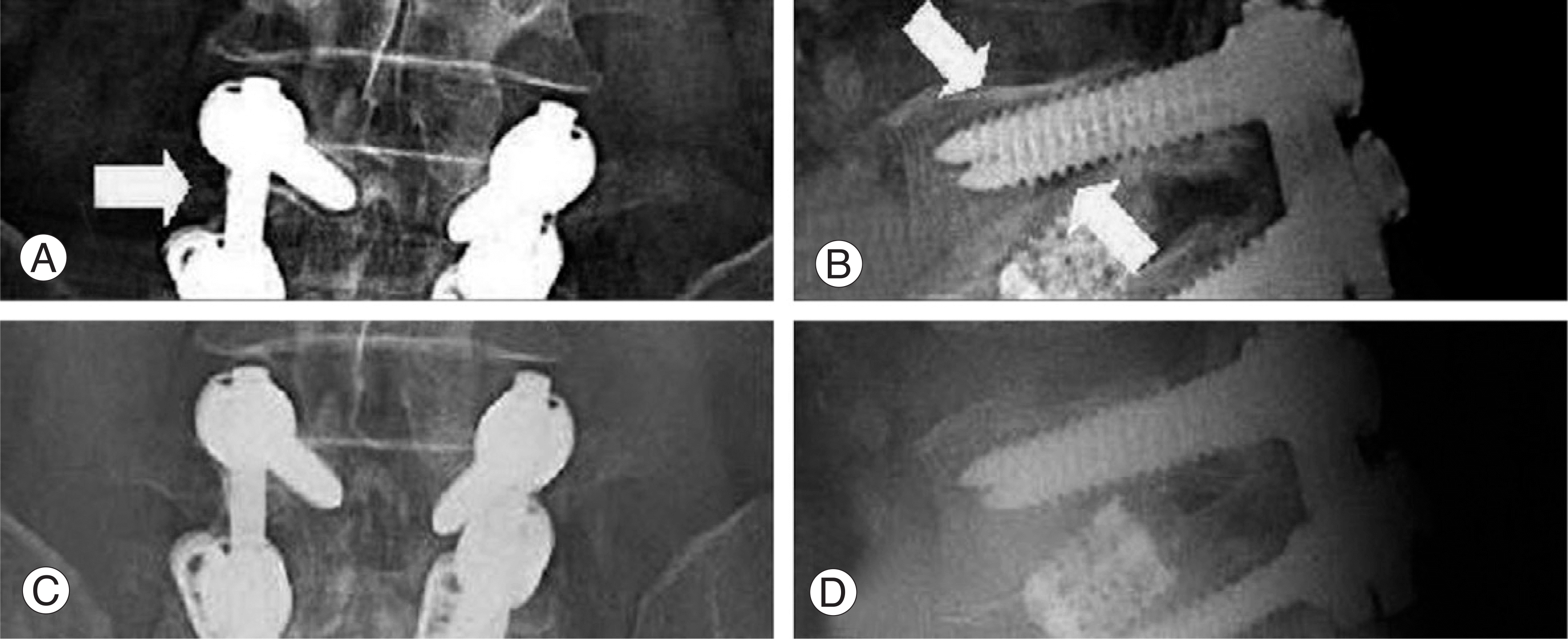Abstract
Summary of Literature Review
Clear zones have been suggested in pseudoarthrosis and a loss of fixation. However, few reports have clearly described the longterm course and clinical significance of clear zones. Materials and Methods:The clear zones were evaluated in 399 patients with pedicle screw fixation after 6 months, 1 year, 2 years and 3 years. The patient was considered to be clear zone positive when 1 mm or greater circumferential lucency was confirmed around a screw on film from 2 or more directions. The time-course of the clear zones was examined with regard to age, number of levels fused, bone union, fusion method and reoperation.
Results
After 6 months, clear zones were observed in 124 patients (31.1%) but the clear zone-positive rate decreased with time. Clear zones were observed in 89 patients(22.3%), 44 patients(11.0%) and 41 patients(10.3%) after 1 year, 2 years and 3 years, respectively. No new clear zones had developed after 6 months. At the final followup, pseudoarthrosis was observed in 12 patients(3.0%). Among them, 11 were clear zone-positive and 1 was clear zone-negative. There was a statistically significant relationship between the clear zone-positive rate and multilevels, older age and nonunion during following up. In addition, there was a relatively lower clear zone-positive rate in posterolateral fusion combined with posterior lumbar interbody fusion than only posterolateral fusion. However, the difference between them was not statistically significant.
Go to : 
REFERENCES
1). Tokuhashi Y, Matsuzaki H, Oda H, Uei H. Clinical course and significance of the clear zone around the pedicle screws in the lumbar degenerative disease. Spine. 2008; 33:903–908.

2). Fischgrund JS, Mackay M, Herkowitz HN, et al. .:. Degenerative lumbar spondylolisthesis with spinal stenosis: a prospective, randomized study comparing decompressive laminectomy and arthrodesis with and without spinal instrumentation. Spine. 1997; 22:2807–2812.
3). Tokuhashi Y, Nishimura T, Matsuzaki Y. Clinical results of more than 10 years after posterolateral fusion with pedicle screw fixation for degenerative lumbar spondylolisthesis. Spine. 2004; 17:185–192.
4). Bae SW, Kwak HY, Song BY, Yoo JC, An YJ. Radiolucent Zones Surrounding Transpedicular Screws After Lumbar Spinal Instrumented Fusion. J Korean Soc Spine Surg. 2005; 12:115–122.

5). Alanay A, Vyas R, Shamie AN, Sciocia T, Randolph G, Wang JC. Safety and efficacy of implant removal for patients with recurrent back pain after a failed degenerative lumbar spine surgery. J Spinal Disord Tech. 2007; 20:271–277.

6). Sande′n B, Olerud C, Petren-Mallmin M, Johansson C, Larsson S. The significance of radiolucent zones surrouding pedicle screws. Definition of screw loosenins in spinal instrumentation. J Bone Joint Surg Br. 2004; 86:457–461.
7). Slone RM, MacMillan M, Montgomery WJ. Spinal fixation. Part3. Complications of spinal instrumentation. Radiographics. 1993; 13:797–816.
8). Ozawa T, Takahashi K, Yamagata M, et al. .:. Insertional torque of the lumbar pedicle screw during surgery. J Orthop Sci. 2005; 10:133–136.

9). Steinmann JC, Herkowitz HN. Pseudoarthrosis of the spine. Clin Orthop Relat Res. 1992; 284:80–90.
10). Jang EC, Hwan SJ, Song KS, Ryu HS. A Biomechanical Study of Two Kinds of Tapered Pedicle Screws in Osteoporotic Lumber Spine. J Korean Orthop Assoc. 1999; 34:955–962.

11). Kant AP, Daum WJ, Dean SM, Uchida T. Evaluation of lumbar spine fusion. Plain radiographs versus direct surgical exploration and observation. Spine. 1995; 21:2313–2317.
12). Foley MJ, Calenoff L, Hendrix RW, Schafer MF. Thoracic and lumbar spine fusion: postoperative radiologic evaluation. Am J Roentgenol. 1983; 141:373–380.

13). C Lee, J Dorcil, TE Radomisli. Nonunion of the spine: A Review. Clin Orthop Relat Res. 2004; 419:71–75.
14). Glaser J, Stanley M, Sayre H, Woody J, Found E, Spratt K. A 10-year followup evaluation of lumbar spine fusion with pedicle screw fixation. Spine. 2003; 28:1390–1395.

15). Kim NH, Lee HM, Lee WS. The effect of bone mineral density on instrumented spine fusion. J Kor Spine Surg. 1994; 1:133–139.
16). Pihlajamaki H, Myllynen P, Bostman O. Complications of transpedicular lumbosacral fixation for non-traumatic disorders. J Bone Joint Surg Br. 1997; 79:183–189.
17). Cook SD, Barbera J, Rubi M, Salkeld SL, Whitecloud TS 3rd. Lumbosacral fixation using expandable pedicle screws. an alternative in reoperation and osteoporosis. Spine J. 2001; 1:109–114.
Go to : 
Figures and Tables%
 | Fig. 1.Assessment of clear zones around pedicle screws. (A), (B) The presence of a 1 mm or greater radiolucent zone (arrows) around a screw on the radiograph was regarded as clear zone positive. |
 | Fig. 2.Reoperation in case of pseudoarthrosis 70-year-old man with PLF for spinal stenosis L1-2, 2-3, 3-4, 4-5, L5-S1 (A), (B): Dynamic view showing angular motion on L5-S1. (C), (D) Postoperative X-ray showing metal removal and expandable screw fixation & bone graft and PLIF. |
 | Fig. 3.Disappearance of clear zones around pedicle screws: 60-year-old woman with PLF for spinal stenosis L5-S1 with degenerative spondylolisthesis (A), (B): Clear zones (arrows) around pedicle screws were observed at 6 months (C), (D): Clear zones around pedicle screws disappeared at 3 years. |
Table 1.
Relationship between clear zone and age
| Clear zone | 6 months | 3 years | ||
|---|---|---|---|---|
| <60 yrs | ≥60 yrs | <60 yrs | ≥60 yrs | |
| Positive | 34 | 90 | 9 | 32 |
| Negative | 123 | 152 | 148 | 210 |
| Total | 157 | 242 | 157 | 242 |
| p-value | p<0.001 | p=0.018 | ||
Table 2.
Relationship between clear zone and number of levels
| Clear zone | 6 months | 3 years | ||
|---|---|---|---|---|
| 1 level | ≥2 levels | 1 level | ≥2 levels | |
| Positive | 15 | 109 | 4 | 37 |
| Negative | 70 | 205 | 81 | 277 |
| Total | 85 | 314 | 85 | 314 |
| p-value | p<0.001 | p<0.001 | ||
Table 3.
Relationship between clear zone and bone union
| Bone union | Clear zone - 6 months | Clear zone - 3 years | ||
|---|---|---|---|---|
| Positive | Negative | Positive | Negative | |
| Positive | 112 | 275 | 30 | 357 |
| Negative | 12 | 0 | 11 | 1 |
| Total | 124 | 275 | 41 | 358 |
| p-value | p<0.001 | p<0.001 | ||
Table 4.
Relationship between clear zone and procedure of fusion
| Clear zone | 6 months | 3 years | ||
|---|---|---|---|---|
| PLF* | PLF with PLIF† | PLF | PLF with PLIF | |
| Positive | 34 | 90 | 9 | 32 |
| Negative | 123 | 152 | 148 | 210 |
| Total | 157 | 242 | 157 | 242 |
| p-value | p = 0.57 | p = 0.68 | ||




 PDF
PDF ePub
ePub Citation
Citation Print
Print


 XML Download
XML Download